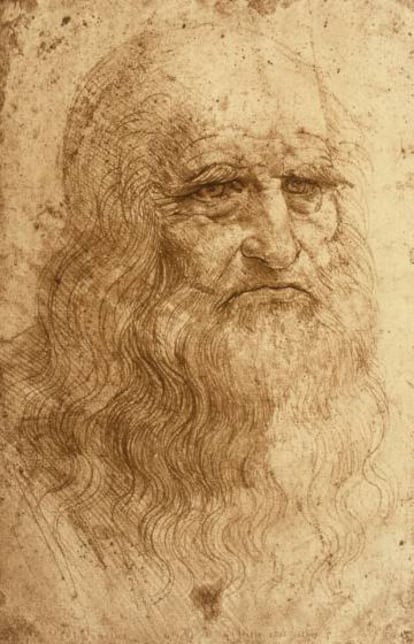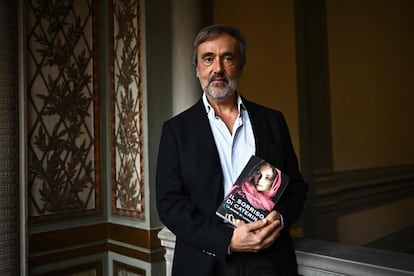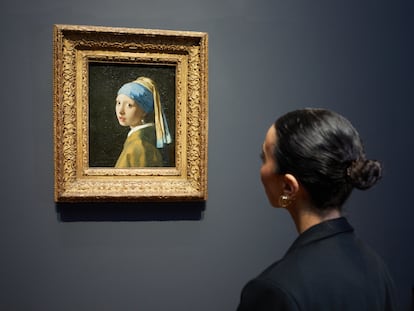Leonardo da Vinci’s mother was a slave, according to new research
Italian historian Carlo Vecce claims the Renaissance master was born to Caterina, a young woman from the Caucasus, who was trafficked to Florence as a child

Renaissance master Leonardo da Vinci was the son of a slave from the Caucasus. That’s according to The Smile of Caterina, the mother of Leonardo, a new book by Italian historian Carlo Vecce that was presented Tuesday in Florence. The research may represent a turning point in studies on Da Vinci, who continues to hold interest hundreds of years after his death.
The work – which comes with many caveats – claims that Da Vinci was born in 1452 as the result of an extramarital affair between Ser Piero da Vinci, a wealthy notary of the Republic of Florence (as Florence was known before Italy’s unification), and Caterina, a girl who was taken from her home in the Caucasus Mountains and sold as a slave. According to the book, Caterina could not speak or write the language of her new home.
The argument that Da Vinci may in fact be half-Italian is based on what Vecce claims is an act of liberation of a slave called Caterina Ser Piero by her mistress Monna Ginerva. At the book presentation on Tuesday, Vecce – who has worked in the past with Da Vinci expert Carlo Pedretti – argued that Ginerva had acquired Caterina as a wet nurse from a Florentine gentleman. The document, which was found in the State Archives in Florence, is dated November 2, 1452 – six months after Da Vinci’s birth – and according to Vecce, is written in the handwriting of Piero da Vinci.

In The Smile of Caterina, the mother of Leonardo, Vecce claims that Caterina was the daughter of a Circassian prince named Jacob, who ruled one of the kingdoms over the highlands of the northern Caucasus Mountains. The historian says that one July morning, when Caterina was just a child, she was abducted by a group of Tartars, and trafficked to Italy.
Vecce explains that slavery was also present in the Italian republics of the Middle Ages, especially for Venetian and Genoese merchants who traded in human beings. According to the historian, in Florence, there was high demand for young women, who would be forced to work as nurses, caretakers, concubines and sex slaves. Caterina was allegedly “recruited” by Donato di Filippo di Salvestroc Nati, an old Florentine adventurer and the husband of Monna Ginevra, “who owned slaves in the Near East and the Black Sea region.”
The documentation presented in the book maintains that Da Vinci, his parents and his mother’s alleged “owners” remained closely linked through their lives. Monna Ginevra’s husband died in 1466, but shortly before his death, he invested money in building a pantheon in the convent of San Bartolomé di Monteoliveto. The notarial deed of this work appears to be signed by Piero da Vinci. In fact, Da Vinci bequeathed one of his early works, Annunciation (1472-1475) to this same church. “It no coincidence,” claims Vecce.
What’s more, the historian points out that the chapel of the Confraternity of the Immaculate Conception in Milan, for whom Da Vinci painted the artwork Virgin of the Rocks, is being rediscovered thanks to the construction works for the new headquarters of the Catholic University of the Sacred Heart. The discovery of possible human remains, according to Vecce, could suggest that the remains of Caterina will be found there.
Sign up for our weekly newsletter to get more English-language news coverage from EL PAÍS USA Edition
Tu suscripción se está usando en otro dispositivo
¿Quieres añadir otro usuario a tu suscripción?
Si continúas leyendo en este dispositivo, no se podrá leer en el otro.
FlechaTu suscripción se está usando en otro dispositivo y solo puedes acceder a EL PAÍS desde un dispositivo a la vez.
Si quieres compartir tu cuenta, cambia tu suscripción a la modalidad Premium, así podrás añadir otro usuario. Cada uno accederá con su propia cuenta de email, lo que os permitirá personalizar vuestra experiencia en EL PAÍS.
¿Tienes una suscripción de empresa? Accede aquí para contratar más cuentas.
En el caso de no saber quién está usando tu cuenta, te recomendamos cambiar tu contraseña aquí.
Si decides continuar compartiendo tu cuenta, este mensaje se mostrará en tu dispositivo y en el de la otra persona que está usando tu cuenta de forma indefinida, afectando a tu experiencia de lectura. Puedes consultar aquí los términos y condiciones de la suscripción digital.
More information
Archived In
Últimas noticias
Most viewed
- Reinhard Genzel, Nobel laureate in physics: ‘One-minute videos will never give you the truth’
- Oona Chaplin: ‘I told James Cameron that I was living in a treehouse and starting a permaculture project with a friend’
- Pablo Escobar’s hippos: A serious environmental problem, 40 years on
- Charles Dubouloz, mountaineering star, retires at 36 with a farewell tour inspired by Walter Bonatti
- Why we lost the habit of sleeping in two segments and how that changed our sense of time











































